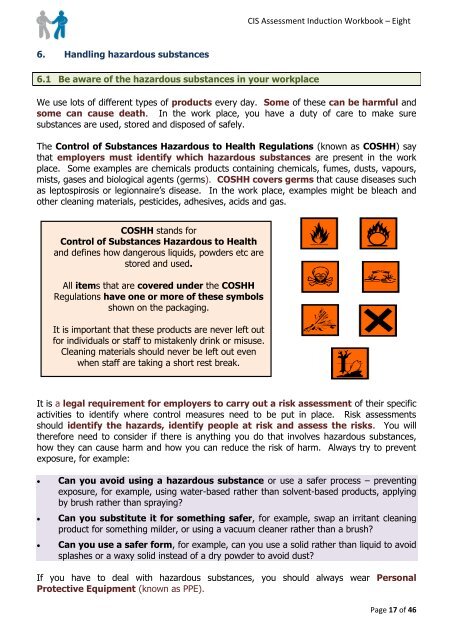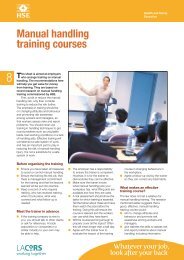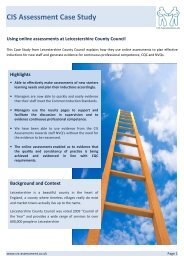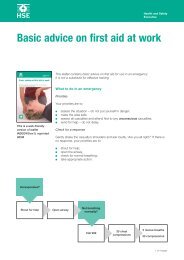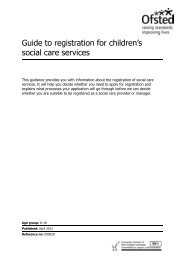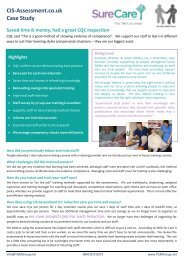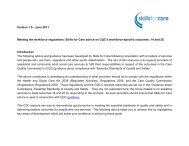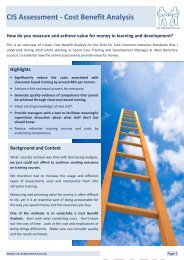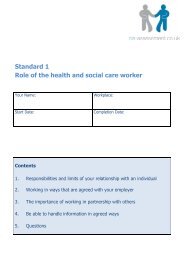Standard 8 Health and safety in an adult social care setting
Standard 8 Health and safety in an adult social care setting
Standard 8 Health and safety in an adult social care setting
You also want an ePaper? Increase the reach of your titles
YUMPU automatically turns print PDFs into web optimized ePapers that Google loves.
6. H<strong><strong>an</strong>d</strong>l<strong>in</strong>g hazardous subst<strong>an</strong>ces<br />
6.1 Be aware of the hazardous subst<strong>an</strong>ces <strong>in</strong> your workplace<br />
CIS Assessment Induction Workbook – Eight<br />
We use lots of different types of products every day. Some of these c<strong>an</strong> be harmful <strong><strong>an</strong>d</strong><br />
some c<strong>an</strong> cause death. In the work place, you have a duty of <strong>care</strong> to make sure<br />
subst<strong>an</strong>ces are used, stored <strong><strong>an</strong>d</strong> disposed of safely.<br />
The Control of Subst<strong>an</strong>ces Hazardous to <strong>Health</strong> Regulations (known as COSHH) say<br />
that employers must identify which hazardous subst<strong>an</strong>ces are present <strong>in</strong> the work<br />
place. Some examples are chemicals products conta<strong>in</strong><strong>in</strong>g chemicals, fumes, dusts, vapours,<br />
mists, gases <strong><strong>an</strong>d</strong> biological agents (germs). COSHH covers germs that cause diseases such<br />
as leptospirosis or legionnaire’s disease. In the work place, examples might be bleach <strong><strong>an</strong>d</strong><br />
other cle<strong>an</strong><strong>in</strong>g materials, pesticides, adhesives, acids <strong><strong>an</strong>d</strong> gas.<br />
COSHH st<strong><strong>an</strong>d</strong>s for<br />
Control of Subst<strong>an</strong>ces Hazardous to <strong>Health</strong><br />
<strong><strong>an</strong>d</strong> def<strong>in</strong>es how d<strong>an</strong>gerous liquids, powders etc are<br />
stored <strong><strong>an</strong>d</strong> used.<br />
All items that are covered under the COSHH<br />
Regulations have one or more of these symbols<br />
shown on the packag<strong>in</strong>g.<br />
It is import<strong>an</strong>t that these products are never left out<br />
for <strong>in</strong>dividuals or staff to mistakenly dr<strong>in</strong>k or misuse.<br />
Cle<strong>an</strong><strong>in</strong>g materials should never be left out even<br />
when staff are tak<strong>in</strong>g a short rest break.<br />
It is a legal requirement for employers to carry out a risk assessment of their specific<br />
activities to identify where control measures need to be put <strong>in</strong> place. Risk assessments<br />
should identify the hazards, identify people at risk <strong><strong>an</strong>d</strong> assess the risks. You will<br />
therefore need to consider if there is <strong>an</strong>yth<strong>in</strong>g you do that <strong>in</strong>volves hazardous subst<strong>an</strong>ces,<br />
how they c<strong>an</strong> cause harm <strong><strong>an</strong>d</strong> how you c<strong>an</strong> reduce the risk of harm. Always try to prevent<br />
exposure, for example:<br />
C<strong>an</strong> you avoid us<strong>in</strong>g a hazardous subst<strong>an</strong>ce or use a safer process – prevent<strong>in</strong>g<br />
exposure, for example, us<strong>in</strong>g water-based rather th<strong>an</strong> solvent-based products, apply<strong>in</strong>g<br />
by brush rather th<strong>an</strong> spray<strong>in</strong>g?<br />
C<strong>an</strong> you substitute it for someth<strong>in</strong>g safer, for example, swap <strong>an</strong> irrit<strong>an</strong>t cle<strong>an</strong><strong>in</strong>g<br />
product for someth<strong>in</strong>g milder, or us<strong>in</strong>g a vacuum cle<strong>an</strong>er rather th<strong>an</strong> a brush?<br />
C<strong>an</strong> you use a safer form, for example, c<strong>an</strong> you use a solid rather th<strong>an</strong> liquid to avoid<br />
splashes or a waxy solid <strong>in</strong>stead of a dry powder to avoid dust?<br />
If you have to deal with hazardous subst<strong>an</strong>ces, you should always wear Personal<br />
Protective Equipment (known as PPE).<br />
Page 17 of 46


